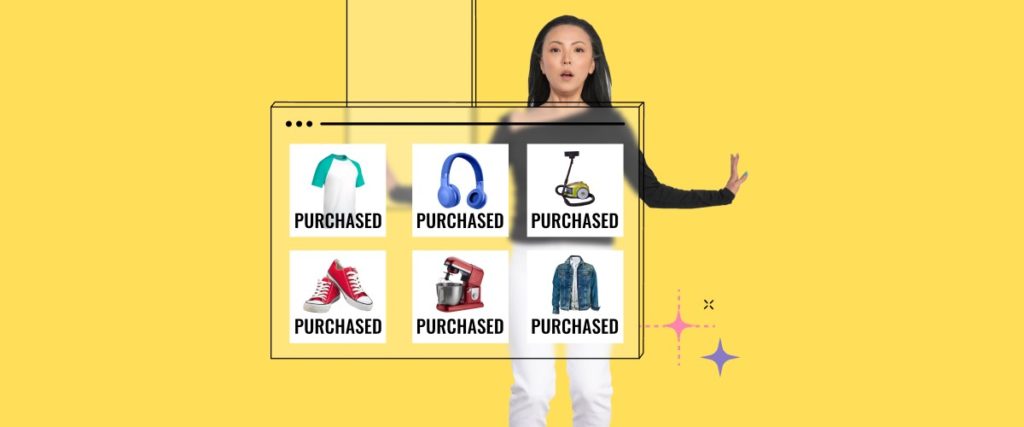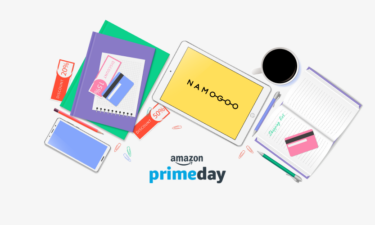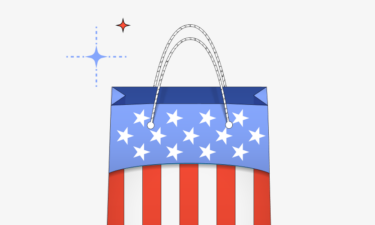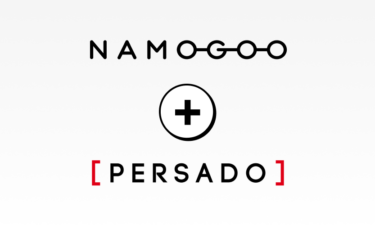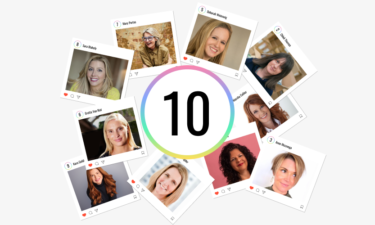Conversion rate optimization is like that bad, on-again-off-again relationship most of us had in college.
When things are going well, it’s exciting and uplifting. But when things are taking a turn for the worse? It’s defeating, frustrating, and can bring up a lot of erratic emotions.
Perhaps you’re reading this article because your efforts to increase your conversion rate aren’t going so well.
Or maybe you’ve just consumed every single piece of content out there with CRO strategies and are looking for something that moves the needle more than a fraction of a percentage point.
If that sounds like you, you’ve come to the right place.
In this article, we’ll cover how you can apply onsite strategies that are based on customers’ unique buying DNA to help your conversion rate skyrocket.
Plus, benefit your other eCommerce KPIs in the process.
Ready? Let’s dive in.
How to Capture Customers’ Buying DNA to Unlock Conversion Rate Growth?
Each and every site visitor expresses a unique buying DNA that changes session by session.
This DNA is composed of their past behavior, expressed and unexpressed buying considerations, motivations and needs, purchasing patterns, technologies and more – all of which signal the customer’s current intent.
And that intent is the single most important variable for eCommerce teams to take action on.
Why?
Because over 2 billion people buy online annually, and each of those online shoppers goes through an average of 140 touchpoints, both online and off, before making a purchase[*].
Every organic result search engines serve to their users is based on user intent. When you engage in paid search, display, or social media advertising, Google, YouTube, or Facebook measures and delivers your ads to those who are most likely to convert based on intent.
The same goes for your online store.
Each and every site visitor expresses intent signals; signals that can be monitored, captured, and leveraged to provide individualized, 1:session customer experiences that are more accurate, capture attention, and lead consumers to act upon.

Taking action on your customer’s purchase intention and unique buying DNA gives you the power to maximize the potential of each visitor, personalize the onsite customer experience, reduce shopping cart abandonment, and elevate your brand image
Let’s go over how each of these factors contributes to conversion rate optimization.
#1. Harness the Potential of Each Session
When your customers are browsing your site and they put an item in their digital shopping cart, this is a pivotal moment in their customer journey.
This is the moment their shopping behaviors switch from communicating an investigative or navigational intent, to a transactional intent. Their purchase propensity accelerates.
This is a critical moment to keep them engaged until they convert. Why? Because if you don’t, you lose twice over:
- You already paid to bring these visitors to your site. They’re showing a high intent to buy, and leaving them unattended is just like leaving money on the table.
- If they bounce before converting, they’ve lost their forward momentum. Their customer journey is interrupted, and they are even made vulnerable to your competitors.
Yes, really.
Your brand nurtured these visitors’ purchase intention, priming them for conversion. They’re in the market for the products your brand offers; but now that their data communicates intent, their purchase propensity, psychographics, and behavioral analytics can be used by advertising platforms to serve competitor ads to them.
Meeting each visitor where they’re at by tailoring their experience based on their intent enables you to offer exactly what they need to convert.
#2. Personalize the Customer Experience
eCommerce personalization boasts an average of a 20x return on investment[*].
Nearly 50% of consumers report making an impulse purchase after seeing a personalized promotion from a brand, 39% say they’re likely to refer a friend, 32% say they leave positive reviews, and 22% report being more likely to post about the brand on social[*] (UGC for the win!)

Personalization works so well because tailoring the experience to each shopper ensures that they see the products, incentives, and messaging that they’re most likely to actually act on.
Personalization empowers brands to provide a more targeted experience based on visitors’ past and current browsing behavior, technologies and services they use, their brand and product affinity, implicit and explicit intent, and many other types of data.

The more targeted your experience is, the better able to convert you are. And what’s more relevant and individual than personalizing the experience based on shoppers’ buying intent?
NamoGood to Know: Customer buying intention entails a lot more than the shopper’s likelihood to purchase. It takes into consideration each individual’s different signals to infer the most effective incentive for each shopper and predicts when to serve the promotion. Some visitors need an incentive almost right away to keep them on-site, while others want to browse before being offered a conversion incentive.
As purchase decisions aren’t straightforward or linear, every touchpoint along the customer journey influences the purchase decision.
If you fail to personalize your potential customer’s experience to meet their intent, even if they haven’t yet reached transactional intent, you’re neglecting those crucial inflection points, and you’ll leave conversions on the table.
#3. Reduce Shopping Cart Abandonment
On average, 69% of eCommerce shoppers abandon their carts.
Since those who abandon their carts aren’t converting, the higher your cart abandonment rate is, the lower your conversion rate will be.
So reducing your cart abandonment rate logically must improve your conversion rates as well, provided that nothing else changes to reduce your add-to-cart rate simultaneously!
Utilizing customer intent data like with Intent-Based Promotions enables eCommerce brands to serve the exact, minimum offer to drive the user to convert but by doing so at the right time during each session. That way, you can incentivize same-session conversions by offering the incentive users actually want… when they’re most likely to act on it.
Let’s look at a scenario to illustrate the value of providing the most relevant promotion to each individual at the right time.
Say there are two users browsing a children’s clothing website at the same time:
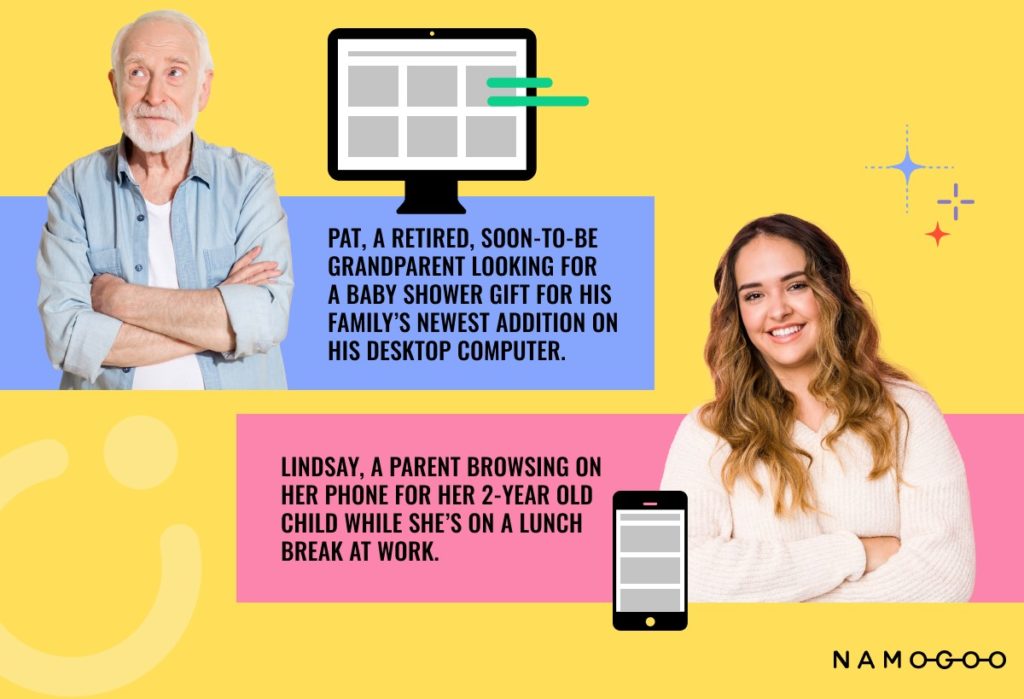
- Pat, a retired, soon-to-be grandparent looking for a baby shower gift for his family’s newest addition on his desktop computer.
- Lindsay, a parent browsing on her phone for her 2-year old child while she’s on a lunch break at work.
If the site in question wasn’t tailoring the experience based on intent, the user experience would likely look something like this:
A visitor lands on website > begins to click around > is served a generic pop-up with a 15% discount offer either after 10 or 15 seconds passes > clicks out of the pop-up as it’s not relevant at the time they see it > adds products to cart > gets distracted or feels unsure > leaves, abandoning the cart.
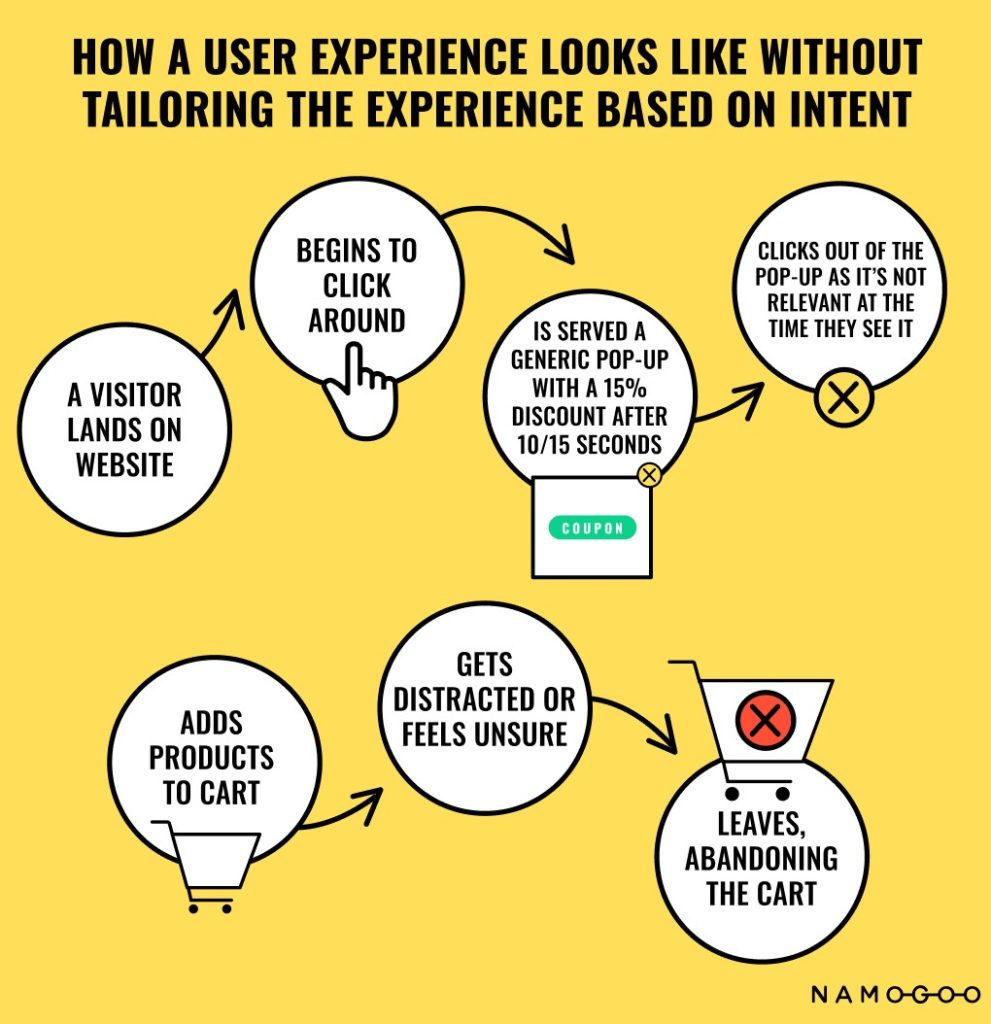
But if the brand did personalize the experience based on intent, it might look something more like this:
Pat: Lands on the website > browses a few pages > takes the gift-finder quiz > adds one of the products to cart > lands on another product page > adds the product to cart > visits cart page and sees subtotal > contemplates comparison shopping > is served with a 10% discount offer (the minimum promotion Pat requires to convert) just before he went back to Google to see what else was available.
Lindsay: Lands on the website > browses a few pages > adds products to cart > checks the time and notices that she has a meeting in 20 minutes > adds one more product to cart > is served with a free shipping offer (the minimum promotion Lindsay requires to convert during) with a countdown timer > checks out before returning back to work.
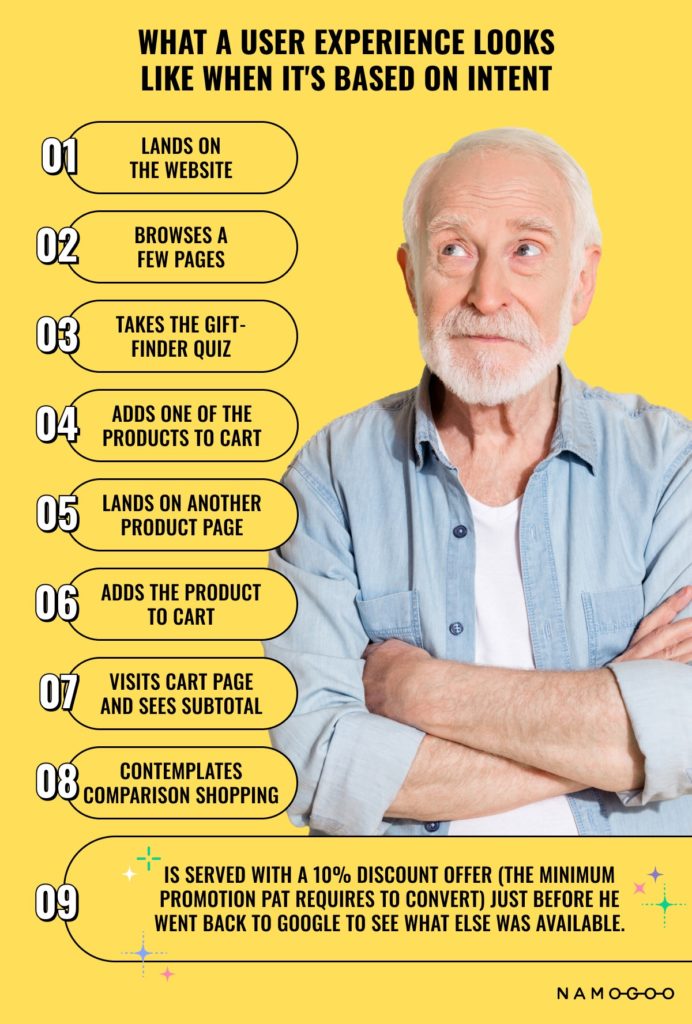
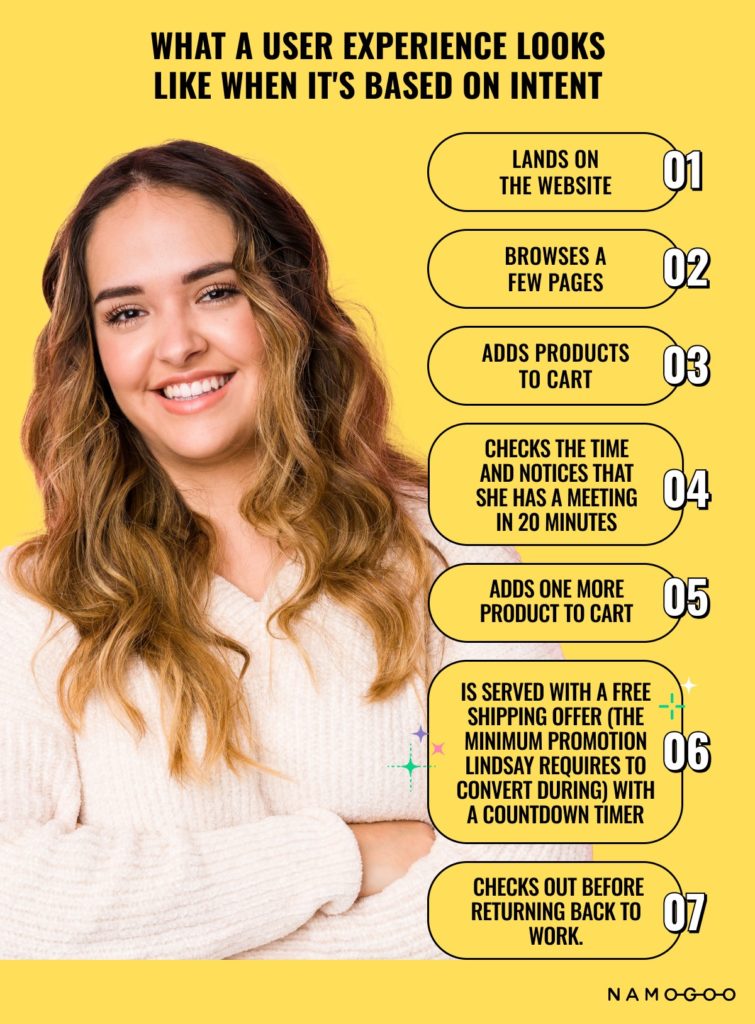
Utilizing customer intent helped these customers complete their orders rather than abandon their carts in the same session. As effective as many cart recovery strategies are, none are as effective as converting the shopper during the same session.
#4. Upholds and Elevates Customer Perceived Value
The path to purchase is a complex and long, multi-step road.
The average customer journey with a brand sees multiple touchpoints.
Bigger-ticket items that require more complex decision-making, like technology products, can expect to see a greater number of touchpoints than inexpensive or necessity products like food and grocery.
But regardless of your industry, the majority of your site visitors will come into contact with your brand more than once throughout their purchasing journey.
So if you have a visitor named Sally who lands on your eCommerce site for the first time while she’s researching her options, she’d see the same offer that she’d see on her second or third visit…

Even though Sally has no intent to purchase at this point in time. She’s still seeing what’s out there!
By the time Sally is ready to place an order, she’s seen the same promotion being offered indiscriminately during each session. She might begin to wonder whether your products are worth the price you list them for in the first place.
In other words, Sally’s perception of the value of your products has been harmed.
Remember: Even if she does decide to accept the offer and convert, providing a promotion when she is in the awareness and consideration phases of her journey trains her to expect a discount in order to complete her purchase.
And if you offer one, it kicks off the vicious and harmful cycle of promotions.
Rather than training visitors to expect a promotion regardless of their intent and devaluing your products, taking action on your customer’s intent avoids degrading your customer perceived value by providing discounts to those who either were willing to pay full price or had no intention to purchase in the first place.
8 Strategies to Improve Conversion Rate Through Customer Intent
Below, we’ll outline 8 strategies to increase your eCommerce conversion rate by personalizing your customer journeys, and leveraging shoppers’ behavior, intentions, motivations, and considerations.
These strategies not only increase conversions; they also drive improvements to many other eCommerce KPIs, such as average order value, cart abandonment rate, and discounted rate.
#1. Offer Personalized Conversion Incentives that Enhance The Onsite Shopping Experience
Incentivizing conversions by offering a discount through a promotional pop-up is nothing new for eCommerce stores. In fact, it’s pop-up best practice.
But serving the same generic 10% off welcome coupon to every single site visitor is going to yield you the same generic 10% performance that every eCommerce site gets.
You don’t want that. You want to get the most out of your visitors. You want to charm, engage with, and convert them. And you want to do that more than once, continually improving your customer’s lifetime value.
After all, you’ve spent time, resources, and budget on capturing those users’ attention and driving them to your website.
That’s where intent comes in.
Instead of offering each customer the same, expected conversion incentive as everyone else, tailor it specifically to them.
You don’t have to learn how to read minds to pull it off, Intent-Based Promotions’ machine-learning, AI-powered “Prediction Engine” does that for you.
The machine-learning engine analyzes billions of eCommerce sessions per week along with each visitor’s behavioral, device, and product data to determine the incentive each needs to convert them (if any at all):
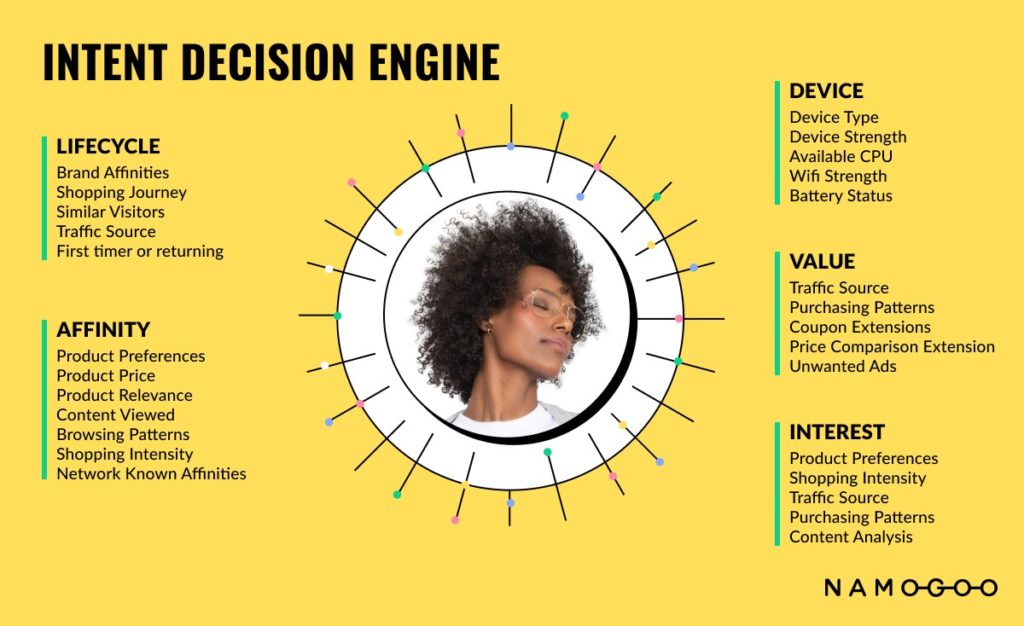
And it does so at the right time, capitalizing on the critical moments of conversion; the moments they’re actively engaged with your brand and have built buyer’s momentum. This can happen throughout their entire journey on your site, not only when they’re actively adding items to their carts.
An intent-based campaign is just as easy (if not easier) to set up as a generic campaign, and you can get a promotion live in less than 10 minutes.
First, log in to Intent-Based Promotions and create a new campaign. (If you haven’t signed up yet, you can schedule a call) Choose Ready to Use.
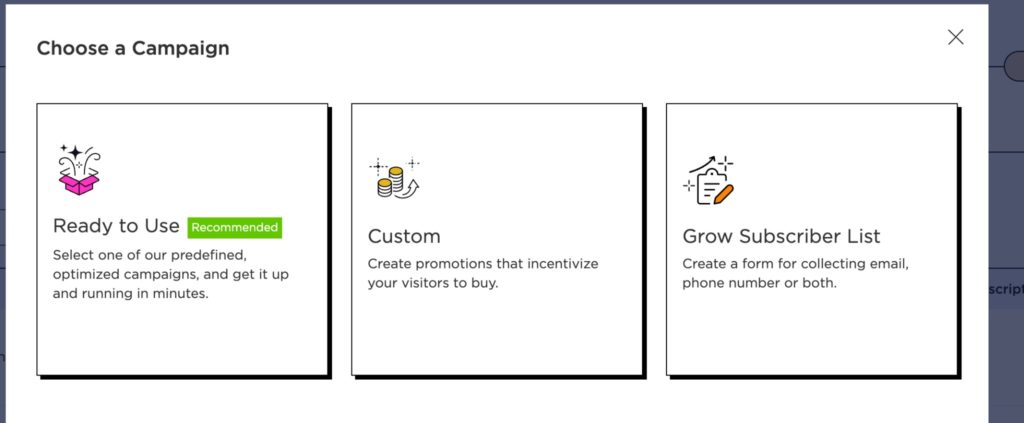
You can choose whichever predefined campaign you’d like, but if this is your first IBP campaign, we recommend sticking with The Best Practice.
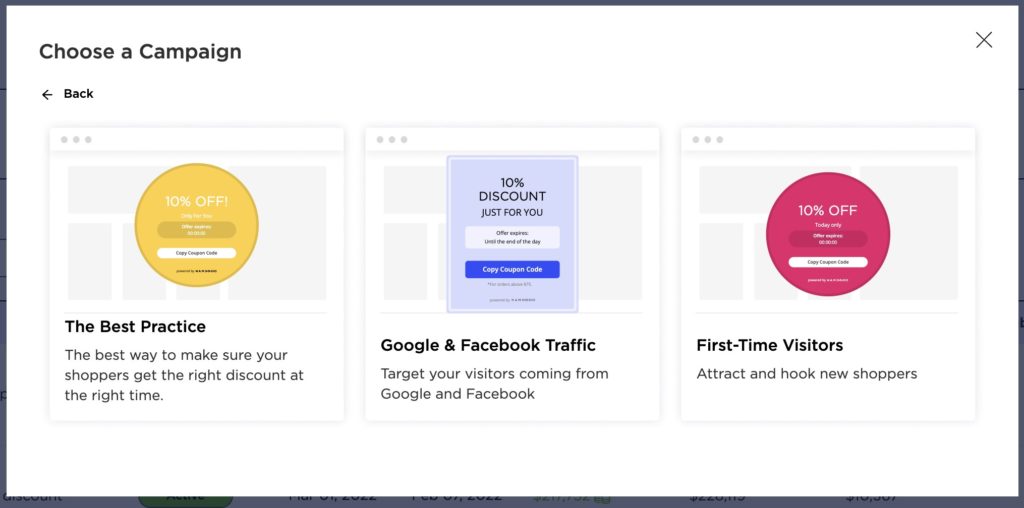
If the Summary window looks good and you’re happy with the discount range, press Publish (and you’re done! Yes, seriously.)
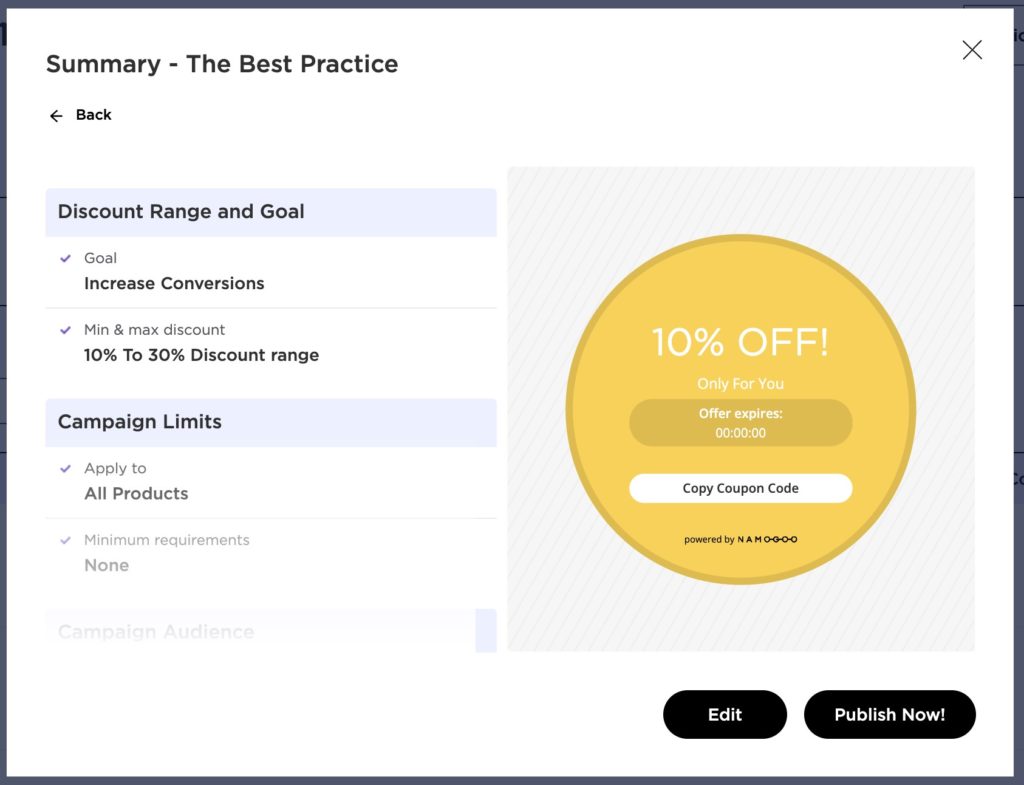
If you have adjustments to make, press Edit. To change the discount range (perhaps you want to decrease the maximum, or increase the minimum), you can do so in the Discount Range and Goal section:
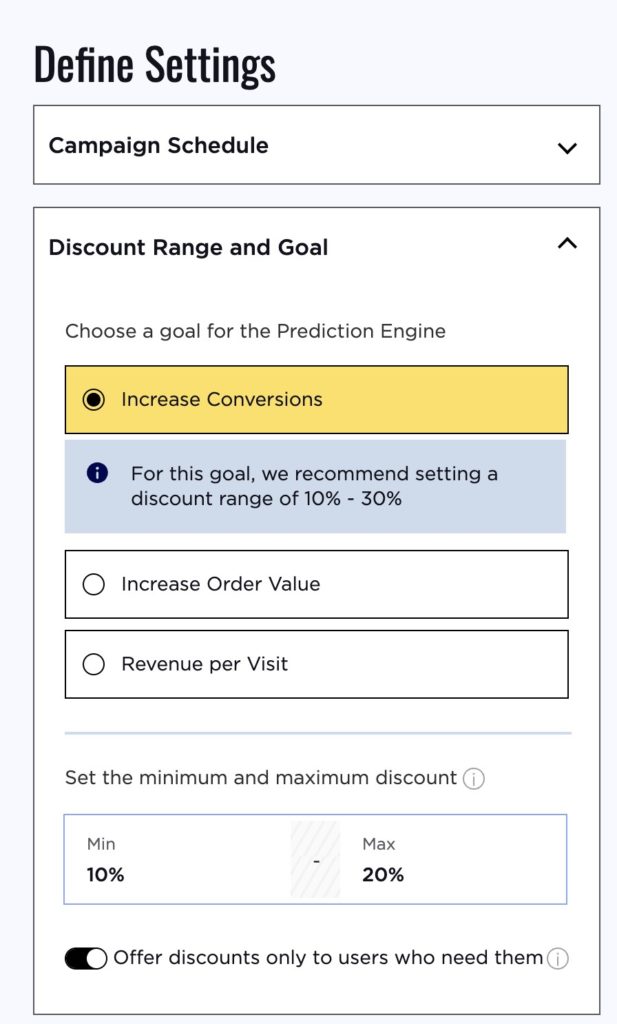
I lowered the maximum to 20% in this example to represent a store that its margins can’t afford to offer a discount above 20%.
We recommend setting your discount range as wide as possible to allow the Prediction Engine to work its magic. It WON’T offer your maximum discount to just anyone, but a broader range will help your campaign turn more visitors into customers, while still offering the lowest discount possible to the rest. So if your margins can handle it, try keeping the 10-30% pre-set range!
You can choose to leave the “Offer discounts only to users who need them” tab toggled on, or turn it off if you prefer.
Under Campaign Limits, you can set the minimum requirements for the promotion. We recommend leaving it as None for this campaign.
Tailor your targeting under the Campaign Audience tab.
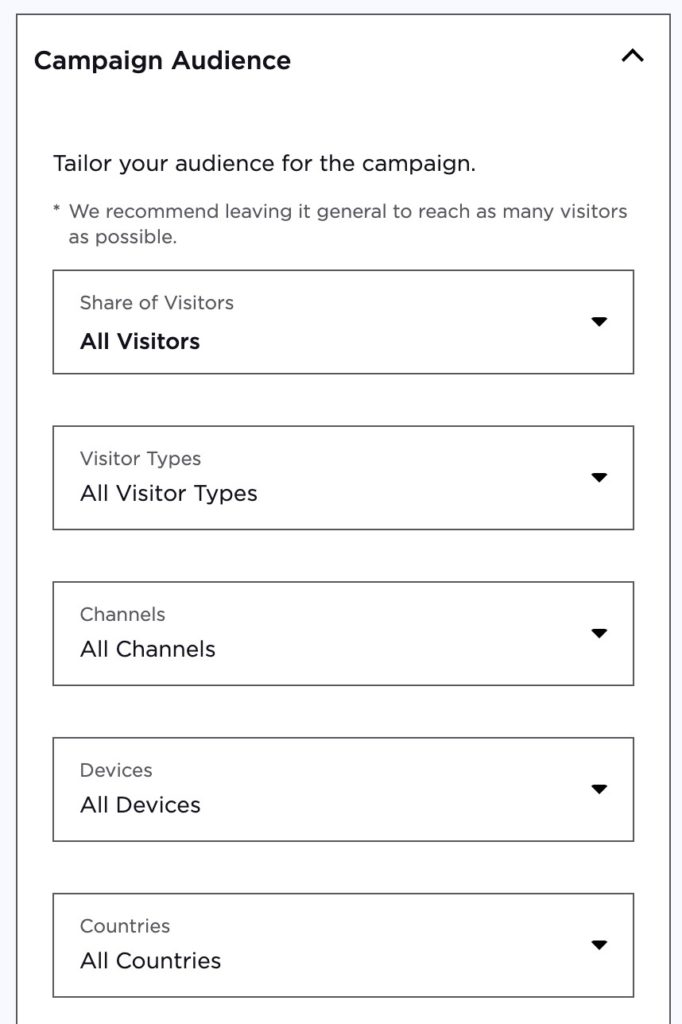
Perhaps you only want to serve the promotion to desktop users, or only to users from certain countries due to shipping constraints.
But if you don’t have any unique circumstances, we recommend leaving your audience broad and letting the Prediction Engine do its magic.
Finally, customize the design of your pop-up to match your branding, and hit “Publish!”
Intent-Based Promotions customers enjoy an average conversion rate uplift of almost 15% – and the majority aren’t using any of the fancy strategies yet, either!
#2. Maximize the Value of Each Session Through Segmented Promotions
The personalized, intent-driven incentive you set up in our last strategy should score your brand a conversion rate uplift while putting margin dollars back into your pocket.
But you can push it even further and also increase your average order value with the simple tweak you’ll learn about here.
This strategy builds off of the last but gets a little more advanced by segmenting your campaigns to serve different types of promotions to new and returning visitors.
Even with your intent-based campaign running, the reality is that most of your visitors will leave without converting. But some of those visitors will return, and serving them – not to mention existing customers who are browsing your store – the same discount promotion as new visitors won’t allow you to push every session to its full potential.
In this strategy, we’ll serve the previous, intent-based discount campaign to new visitors by tailoring the Campaign Audience:

And set up a new campaign for returning visitors. But instead of offering a flat percentage-off discount in this promotion, we’ll boost average order value and conversion rate through a Spend More, Save More campaign.
Why returning visitors, you ask?
- It’s difficult to “untrain” new customers who bought at a steep discount not to expect more steep discounts.
- New customers who receive too-high a discount tend to have low repurchase rates, low LTV, and the highest rate of returns and customer support tickets created. This promotion will feature a higher discount minimum, and by offering it only to returning visitors, you protect your customer lifetime value.
- The spend more, save more offer we’re setting up in this campaign isn’t quite right for most new visitors, because you’re asking them to spend more money on products they’ve never tried before.
In case you’re questioning whether the additional work is worth the potential reward, the answer is yes! In fact, we’re recommending this strategy because it works like a charm for Intent-Based Promotions users.
Check out the results from one customer’s segmented campaigns:
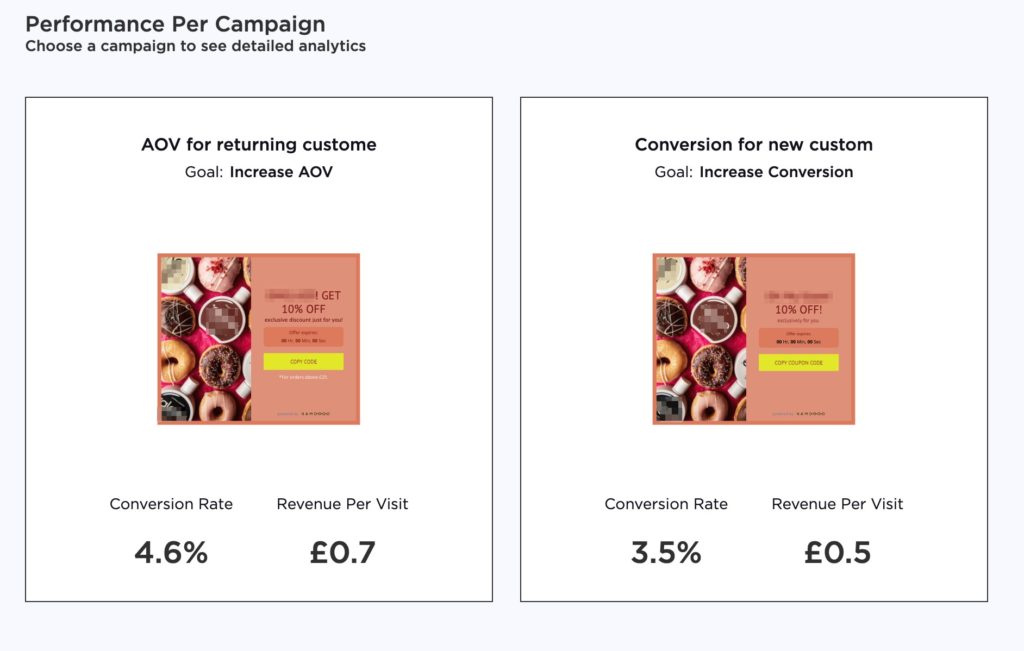
This brand’s conversion rate for returning visitors was 4.6%, an impressive 1.6x higher than the 2021 eCommerce average. Even for new visitors, the brand outperformed the average by nearly 20%.
Here’s how to kick it off.
Create a new Intent-Based Promotion campaign (or, if you don’t yet have an account, schedule a demo here). Select a Ready to Use campaign.
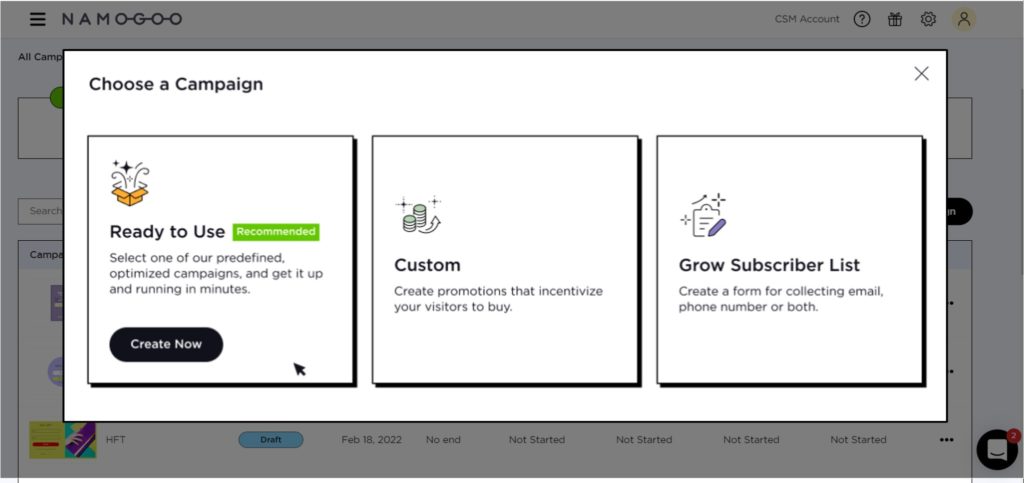
Under “Campaign Type”, choose Intent-Based, and select Discount under Promotion Type.

Choose a template, and press “Next.”
Under Discount Range and Goal, set the discount range you would like to offer. For my example, I set the range to 18-23%.
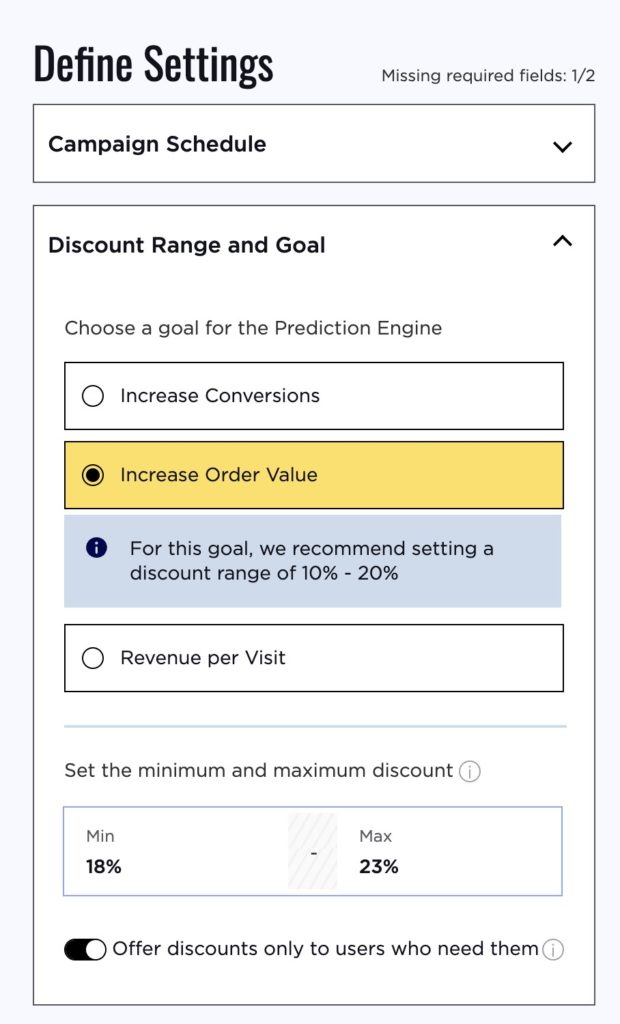
Set a minimum cart value to unlock the discount. We recommend setting it slightly above your current average order value to really move the needle.
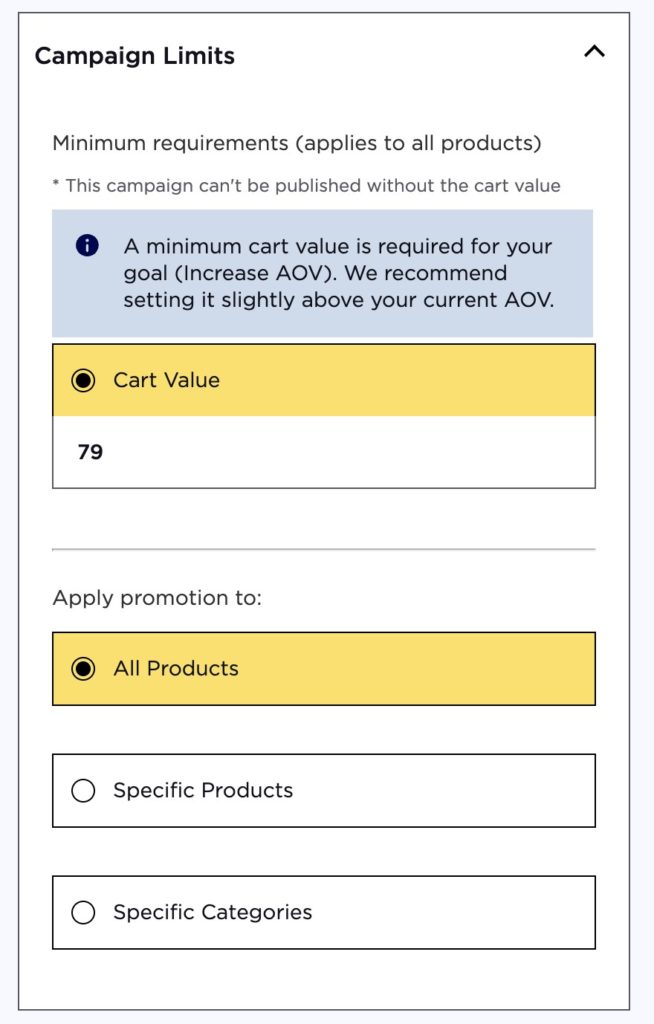
NamoGuru Tip: The higher the minimum cart value on your campaign, the more generous you should be with your minimum discount. If most of your products are priced under $20, and you’re asking returning customers to spend $100 or more to land a 12% discount, your customers may not consider the incentive worth the additional money. Set your minimum discount at 5-10% above your standard welcome offer’s minimum.
Under the next tab, select Returning Visitors under Visitor Types, along with any additional parameters you need to set.
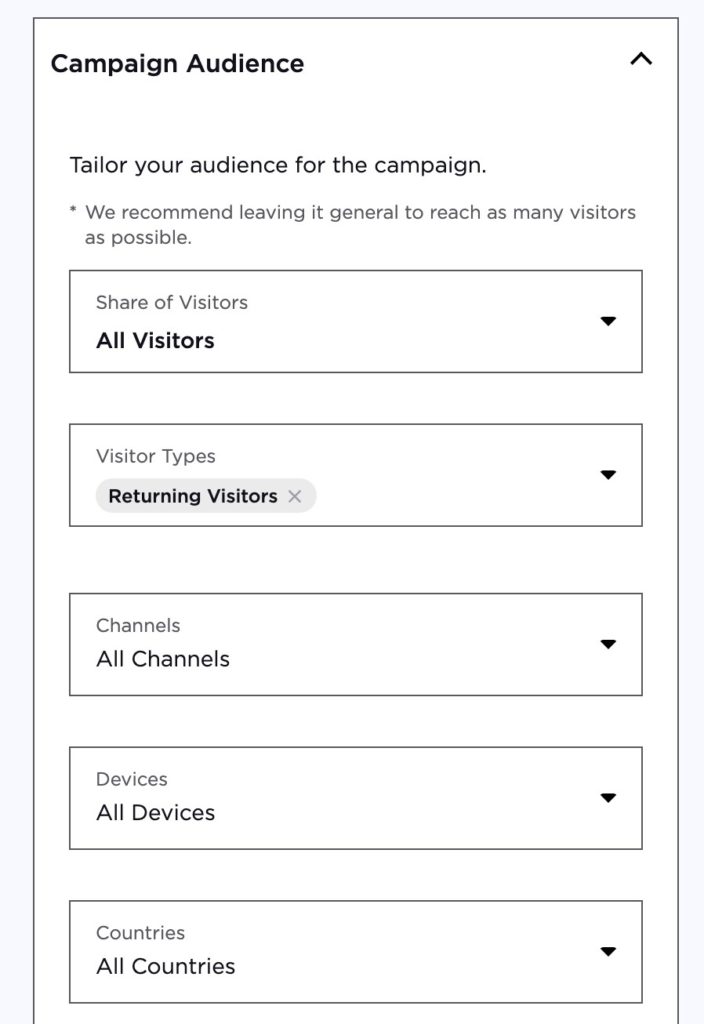
Next up, choose where you’d like the campaign to display on your site. Be careful not to narrow the guidelines too much. The power of intent-based promotions is in the AI-powered Prediction Engine, which analyzes billions of data points to calculate each online shopper’s purchase intention during each session.
Customize the copy, colors, and design of your campaign:
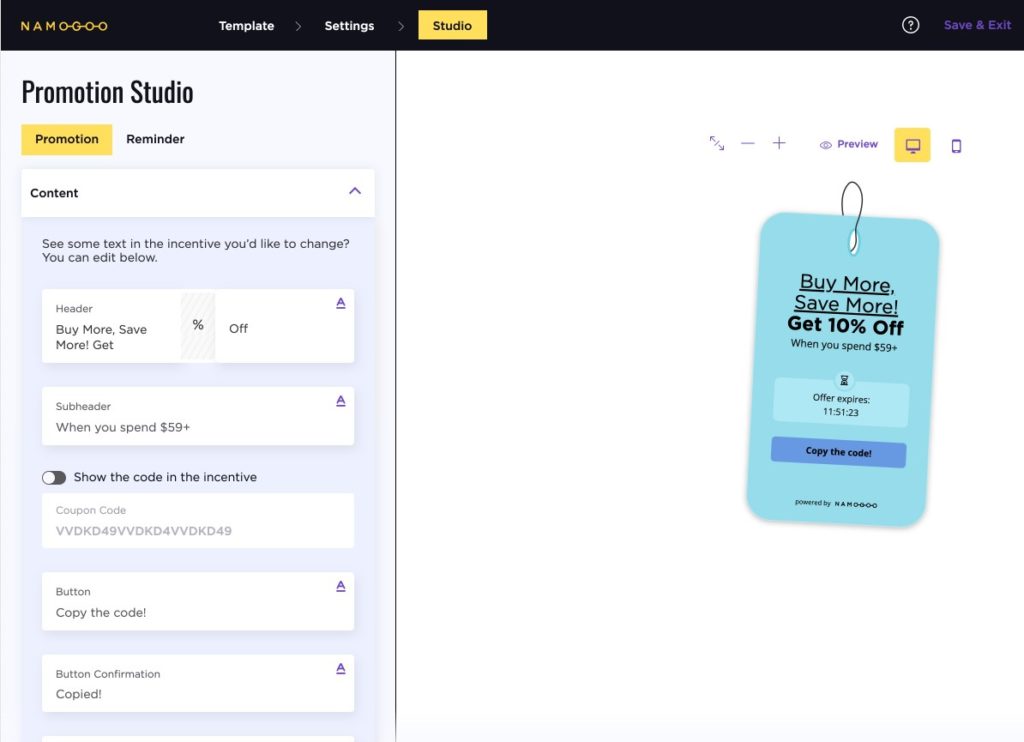
Press “Publish”, and enjoy watching your KPIs soar!
#3. Trigger a Sense of Urgency to Increase Same-Session Conversions
Between 94-98% of your eCommerce store’s visitors won’t convert. And even if they mean to come back to complete their order, unless you give them a reason to do so, most won’t.
If you’ve ever navigated away from a browsing session with the intention of getting back to it later but never quite making it happen, you’ll understand this. You deprioritize making that order in favor of other, more important things in your life and before you know it, you’ve forgotten all about it.
So the key to dealing with this is to ensure you give your visitors a reason to stay on your site and convert in their first session.
A reason like a compelling, time-sensitive, personalized offer.

Rather than offering a discount to anyone at any time, like a welcome coupon, making your promotions active only for a limited time creates a sense of urgency and gives visitors a reason to convert immediately.
Combine that with the first strategy of personalizing the promotion based on intent to offer the incentive most likely to drive each user to convert can be a powerful tool for conversion.
Check out how this Intent-Based Promotion’s customer, a popular slipper brand does this. It offers a dynamic promotion based on customer intent signals. The promotion is only valid for 11 hours, and they use a countdown timer to quickly relay this visually.
Note: Not only do they get a good boost to their same-session conversions, but they also use the Intent Engine to predict the minimal discount each shopper needs to go with the purchase.
You can set this up in under 15 minutes, too. Just head to Intent-Based Promotions (don’t have an account? Schedule a call here). Or go to your promotion tool and start a new campaign (lacking the AI-based discount offering).
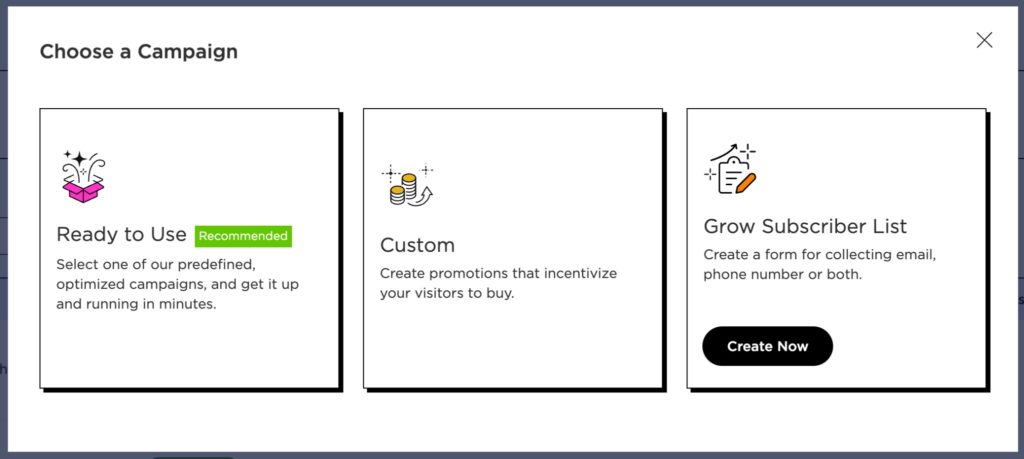
With Intent-Based Promotions, you can choose a Promotion, Our Suggestion, or Grow Subscriber List Campaign. For this example, I chose a Grow Subscriber List campaign to collect email addresses.

If you’re an Intent-Based Promotions customer, choose Intent-Based to tap into the power of the Prediction Engine.

Choose which type of campaign you would like to run. For best results, stack the time-limited offer with another strategy from this article! For this example, I chose Discount under Promotion Type.
Set the campaign limits, audience, and display rules that correspond with the offer you chose.
After you’ve set the campaign limits, audience, and display rules it’s time to decide on the time window you want your offer to be valid for.
To take a data-informed approach to this decision, here are a few tips:
- Create a segment in Google Analytics for engaged users who don’t convert. Then you can see how long these engaged users stay on your site before leaving, and make the offer valid for slightly longer than that.
- If your brand sells higher ticket items or products that require more consideration, like premium, luxury, or tech products, consider checking out the Time Lapse report in Google Analytics and adjusting the time frame accordingly. Pressuring visitors to make a big purchase in just a few hours when their converted counterparts take at least a few days won’t work.
- When in doubt, test different time limits in your campaigns to arrive at the best possible outcome.

Customize your colors and typography to match your branding. Tailor the copy to your promotion, and any design elements.
Next, you have to communicate the time limit on your offer. You have two options: setting a countdown timer as I did in my screenshot above or communicating it through your copy.
NamoGuru Tip: If your pop-up app supports the ability to use countdown timers, consider experimenting with them. Not only do countdown timers visually communicate the time limit on your offer, but they can also help capture user attention before they hit the “x” button on your promotion by using motion.

Publish your promotion, monitor the analytics, and enjoy those conversions!
#4. Increase Conversion Rate & Customer Lifetime Value with the Power of Free
Offering a free gift with purchase is one of the oldest psychological discounting strategies in the books, and that’s because it works.
Getting something for free is magnetic to consumers, regardless of your brand’s industry, products, target audience, and the type of customers your brand attracts.
But this strategy doesn’t stop there. It uses consumers’ obsession with “free” to not only convert, but to drive high-value conversions.
It does so by offering a free (or discounted) gift card for future use when shoppers meet a minimum order value or buy a high-value product. And consumers love free gift cards!
Besides driving AOV by encouraging customers to spend above the minimum order value to get their free reward, this promotional strategy also:
- Protects brand perception by avoiding the need to drive conversions solely through discounts.
- Improves customer lifetime value. By offering a free or discounted gift card with purchase, you encourage customers to place another order to use their gift card.
You can implement this strategy in just a few minutes and enjoy the conversion rate boost for months to come.
To get started, start a campaign in your promotion app. I’ll use Namogoo’s Intent-Based Promotions in my example below. Intent-Based Promotions will soon have the option to offer shoppers a free gift based on intent.
This is so powerful because you wouldn’t have to offer freebies to everybody! Only the shoppers that need an extra push to get them to buy would receive the free gift card offer.
To get started, start a new campaign in your promotions tool. If you’re an Intent-Based Promotions user, select Intent-Based, and when available, the Buy X, Get Y promotion type.

Choose your template. I chose a Bar template rather than a pop-up, so the user can be reminded of the free gift as they navigate the site.
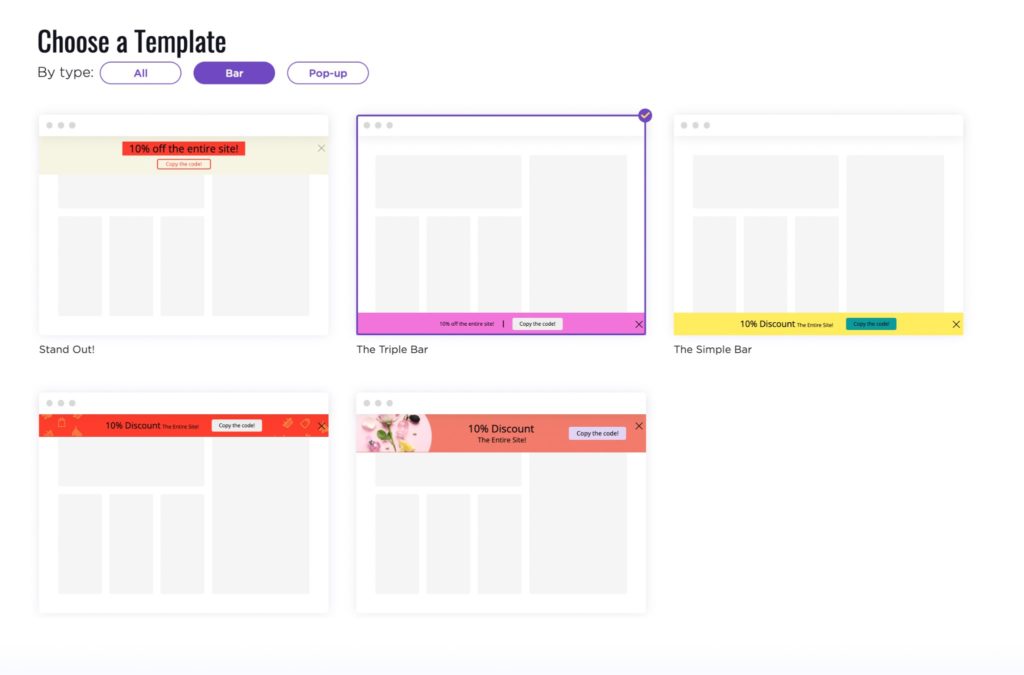
Under Campaign Limits, set the cart value threshold that you want to activate the offer. You might want to set it higher than your other thresholds because a free gift card can be seen as more valuable. For my example, I chose $79.

Select your gift card product under the “Apply promotion to” field:

Then, tailor your display rules and audience for the campaign. This promotion is appealing to both new and returning customers, but you may want to separate them out.
Customize the design of your campaign, and ensure the copy is clear and engaging.
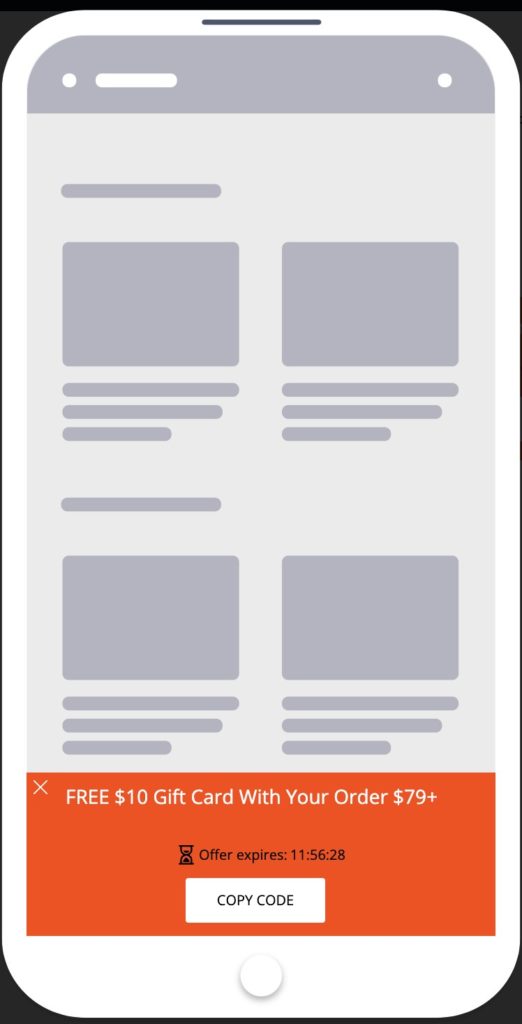
Then, launch your campaign!
#5. Provide a Nudge Without Interrupting the Customer Experience
Even if you craft the perfect promotion strategy, leverage intent to provide the offer most likely to convert each individual shopper, and nail the copy, imagery, and messaging, most of the users who see your promotion will close it before they can take advantage of your incentive.
Users close out of promotional pop-ups almost instinctively. Some do so before they even register what’s being offered, and others simply because they received the promo when they aren’t ready for it yet.
But in most cases, they won’t recall the incentive, and if they do, they won’t be able to remember the discount code. This means that they will miss out on the incentive you were offering, feeling they could score a better deal, and you will miss out on the conversion.
Don’t worry, though. There’s a solution that lets you provide a nudge without interrupting the customer’s browsing experience:
Promotion reminders. A promotion reminder is an icon or tab usually placed around the perimeter of the screen that appears when a pop-up is closed, so the user can recall dismissed promotions later.
To see it in action, check out how this up-and-coming supplement brand not only ties many pop-up best practices into the design and incentive but also displays an eye-catching reminder at the top of the screen when a pop-up is closed.
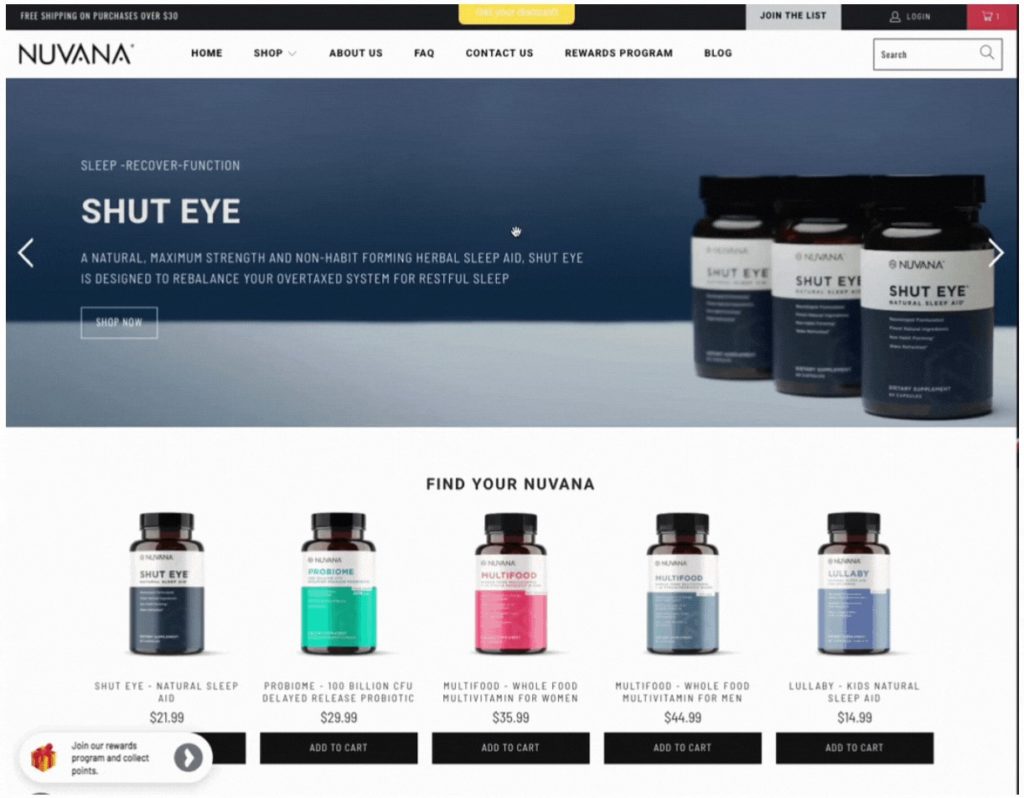
Intent-Based Promotions users can implement promotion reminders in just a couple of minutes. Just activate your Promotion Reminder in the Promotion Studio by clicking on the Reminder tab, and select Show Promotion Reminder.
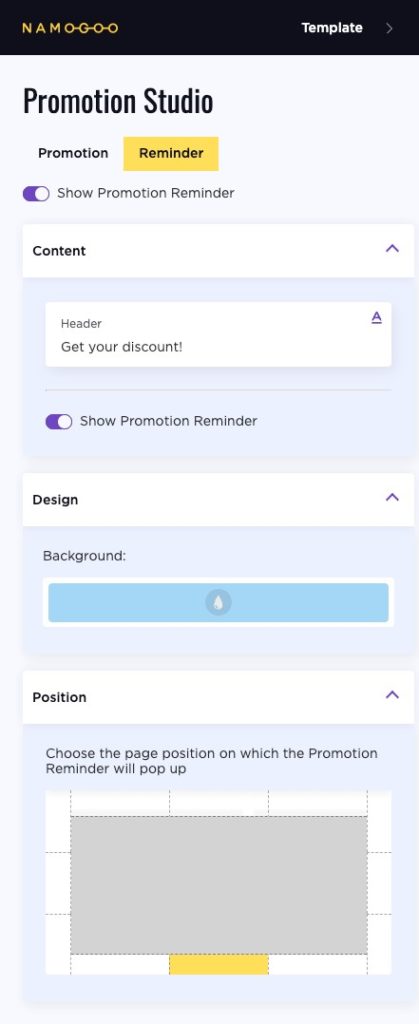
If you don’t use Intent-Based Promotions, check to see if your pop-up app has made this available yet. It may be called a teaser or a nudge in other apps.
#6. Offer Hyper-Relevant Incentives to Grow Your Email and SMS List
Even if your store achieves a conversion rate of double the average, 94% of your visitors leave without converting, and very few will return to make a purchase later.
That is… unless you can collect their email or phone number to bring them back.
With this strategy, you can offer intent-based, enticing incentives that are personalized to each visitor.
And all the visitor has to do to “unlock” that incentive? Sign up for your email list or SMS updates. No more guessing whom to offer this incentive and what is the minimum discount you can offer to get this precious first party data – this strategy does the heavy lifting for you.
Start by creating a new Intent-Based Promotions campaign, and selecting Grow Subscriber List.
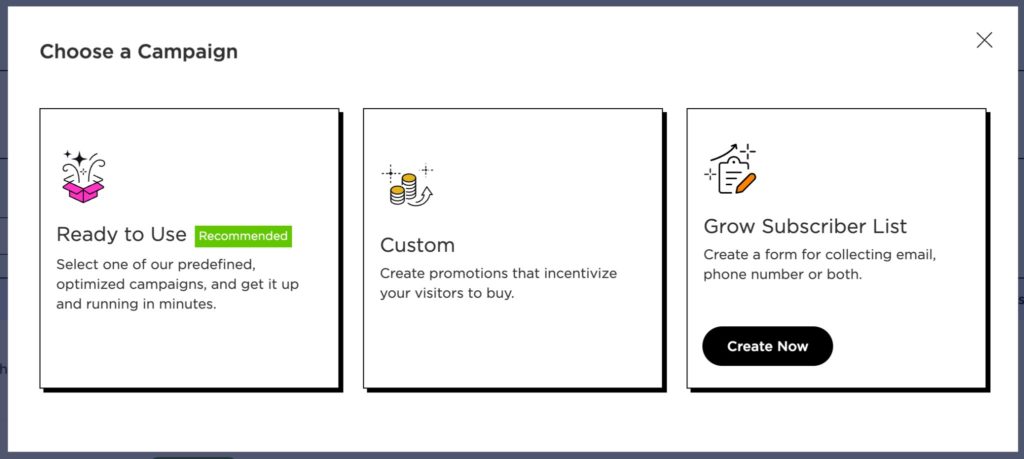
Select an Intent-Based Campaign, and choose your template:

Then, choose the promotion you would like to offer.
NamoGuru Tip: Offer a wide range for this discount, because landing an email or SMS subscriber is highly valuable. Don’t worry though, the Intent Engine will only provide the minimum discount. By providing a wider range you’ll be able to save lost opportunities and capture contact information from shoppers that you would have lost otherwise.
Let your existing and previous campaigns guide which promotion to offer.
I set the promotion as a discount range between 18-23%, with a minimum cart value of $79 (to also boost average order value!)

Customize the design of your promotion, and make sure to add both the email and phone number fields.
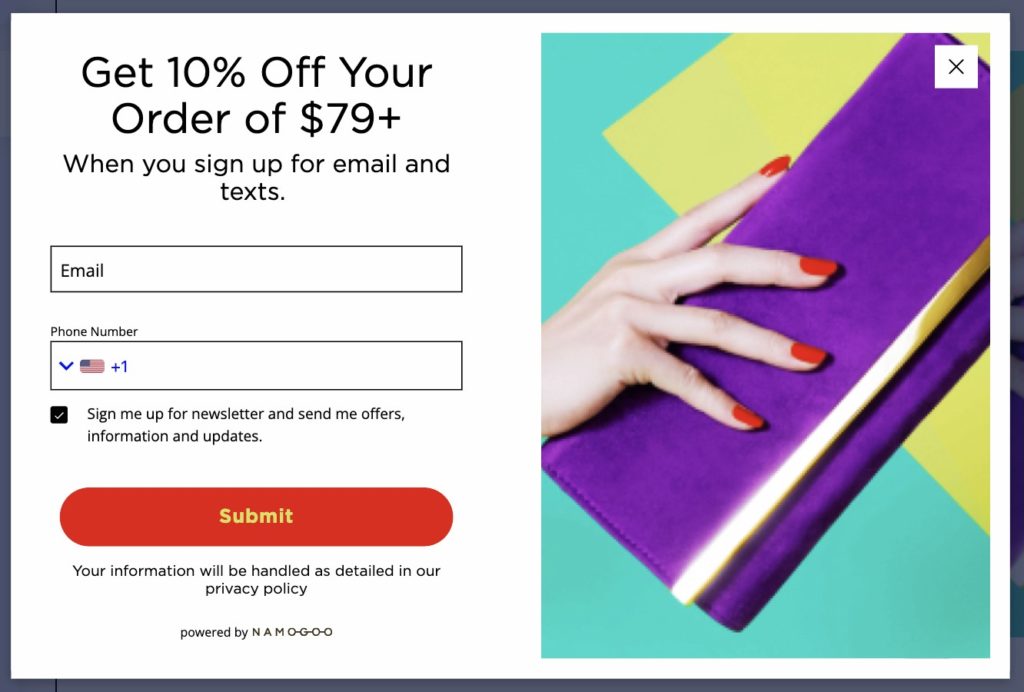
NamoGuru Tip: Email marketing personalization is ideal and requires the subscribers’ name, but the longer the form, the lower the conversion rate (generally speaking). If you want to collect both the phone number and email address, we recommend skipping the name form field.
#7. Incentivize Same-Session Conversions & Provide a Better Customer Experience
Almost 80% of online shoppers cited free shipping as a key factor driving their purchasing decisions[*].
But while there’s no doubt that surprising would-be customers with a shipping charge at checkout can cause you to lose that conversion, there are three problems with offering free shipping universally:
- Taking on the burden of shipping and fulfillment costs for every single order – especially the low-value ones – cuts into margins. It’s pricey to ship single-item orders because the shipping cost takes a bigger piece of the pie. This leaves you with less margin to spend on growth.
- You could be taking on that additional cost unnecessarily. Some users don’t need free shipping to convert (perhaps a direct discount does the trick or they came with high intent to buy a product from you), and giving it away indiscriminately is a losing game.
- It removes the ability for you to leverage a free shipping offer as a time-limited incentive, thereby taking the wind out of your proverbial conversion sails.
So what’s an eCommerce brand to do?
Answer:
→ Offer free shipping…
→ But only to users who are most likely to need it to convert.
→ Incentivize a higher cart value at the same time with a minimum cart threshold…
→ But only when it’s most relevant to users (hint: when they go to check out!)
Yes, this free-shipping strategy performs almost as well as getting rid of shipping charges entirely, but without the downside to margins for your company.
And as an added bonus, this strategy is an effective average order value driver, too, by incentivizing customers to increase their cart value to unlock free shipping.
Finally, you provide a more seamless user experience by only displaying your promotion in the checkout funnel, which is a conversion rate booster, too.
Want proof that this works? Implementing free shipping over a $39 threshold on my Shopify store in mid-June of 2021 was one of the main drivers of a nearly 95% increase in conversion rate over 3 months:

So now that you’re ready to see how to do it, let’s jump in.
First, start a new campaign in your promotions tool. I will be Using Intent-Based Promotions in my example. Choose an Intent-Based campaign so you can capitalize on the AI-powered Prediction Engine to determine which shoppers will respond to this promotion.

Choose Free Shipping under Promotion Type. Next, choose a goal. I chose Increase Conversions.
Under Campaign Limits, select Cart Value and set your minimum cart value threshold to unlock free shipping. I set mine at $39 because that was my existing average order value, and I wanted to incentivize my customers to add more products to their carts.
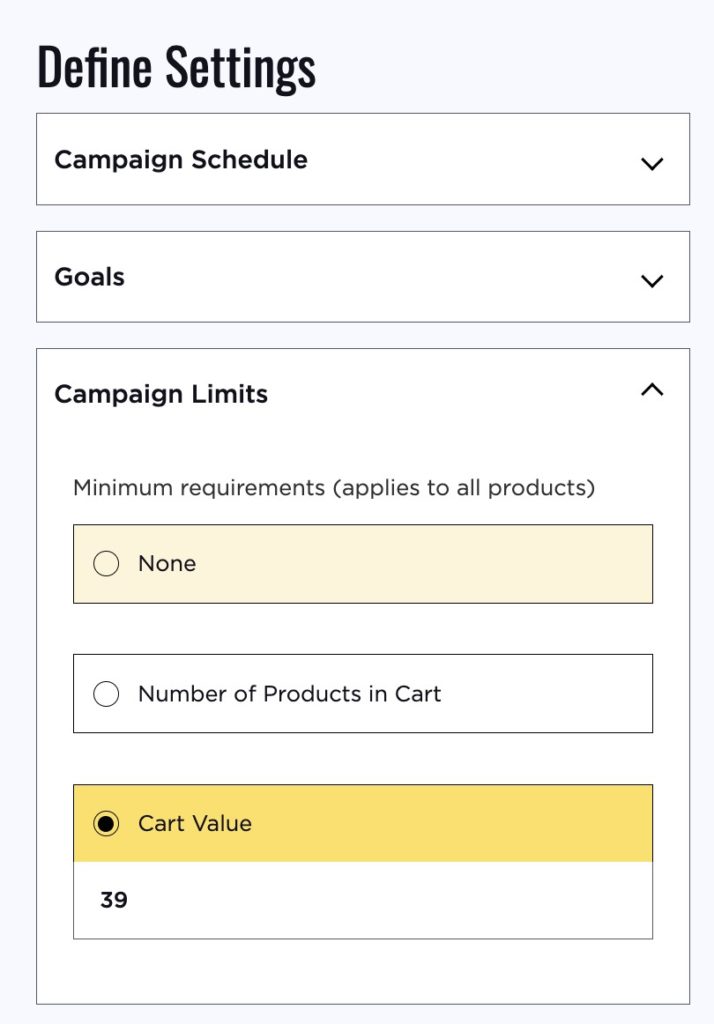
Tip: Be mindful of your audience targeting when you’re setting up your free shipping threshold offer. Fulfillment and shipping costs are much higher for international orders, so I’ve refined the campaign targeting settings to only display for US-based visitors.
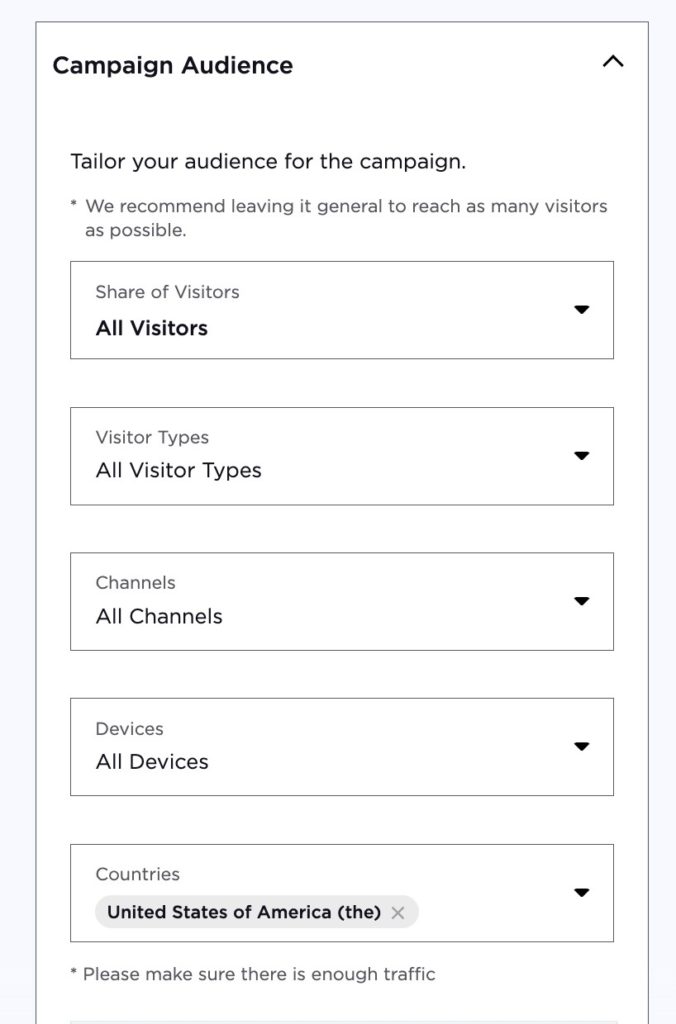
In your Display Rules, you can let the prediction engine calculate when it’s best to display the free shipping to each one of your visitors based on their changing level of intent or set it to appear only on the cart page.
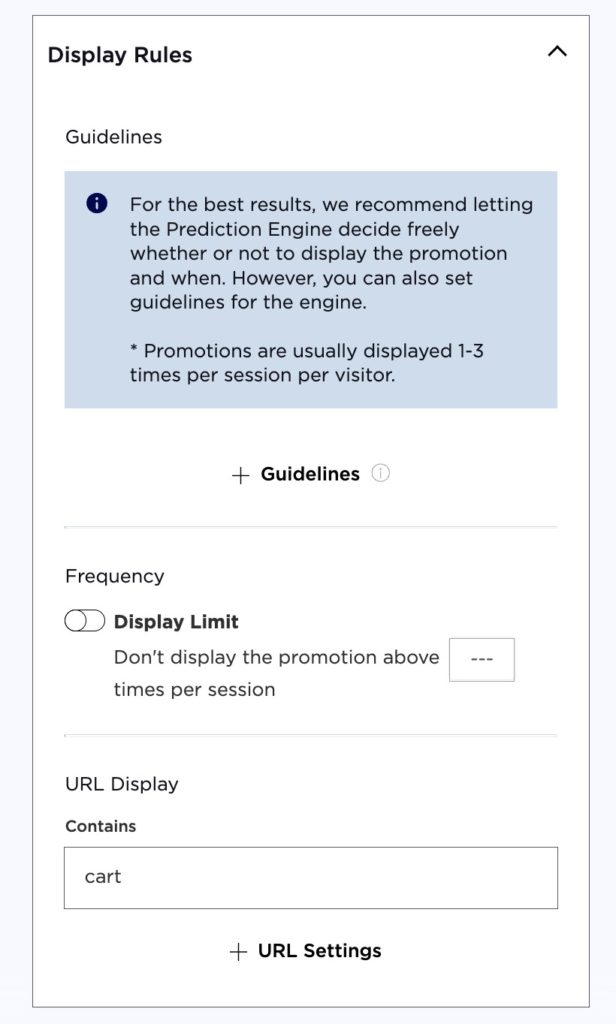
Customize your Campaign’s design to fit in with your branding, and tailor the copy to communicate your offer:
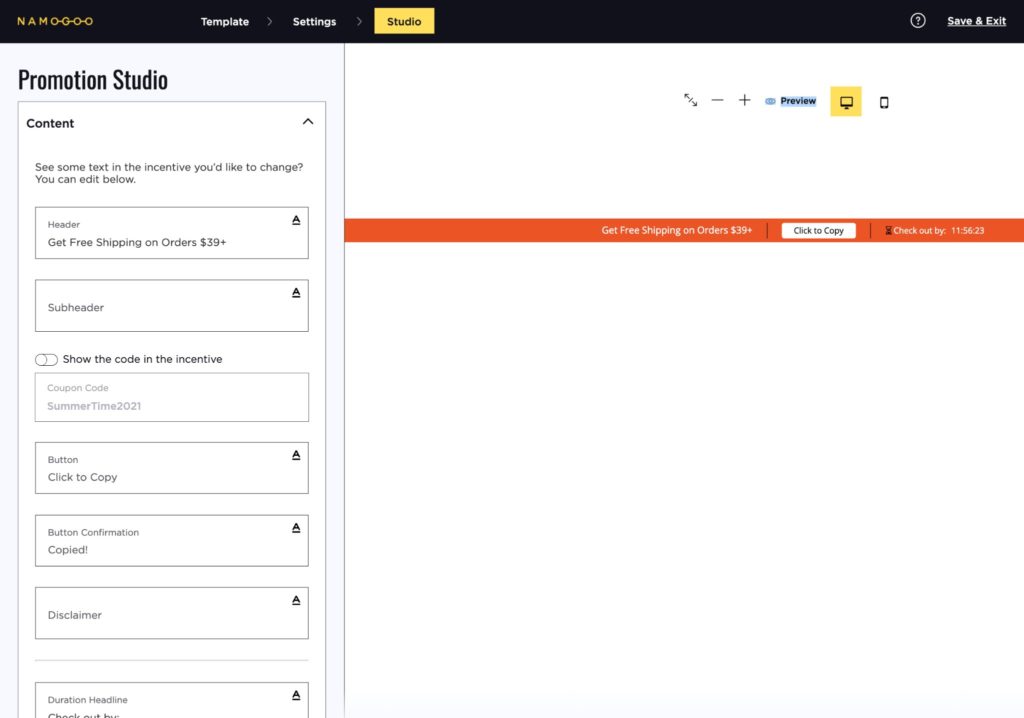
You can trigger that sense of urgency we went over earlier to encourage same-session conversions by selecting a template with a countdown timer. I adjusted the copy on my example campaign and selected Countdown for the Duration Mechanism to provide that eye-catching, urgency-inducing countdown movement.

Under Position, you can either choose for the banner to be sticky or not sticky.
We recommend choosing a sticky banner so it will move down the page with your user. That way they don’t lose sight of the promotion or forget what is being offered.
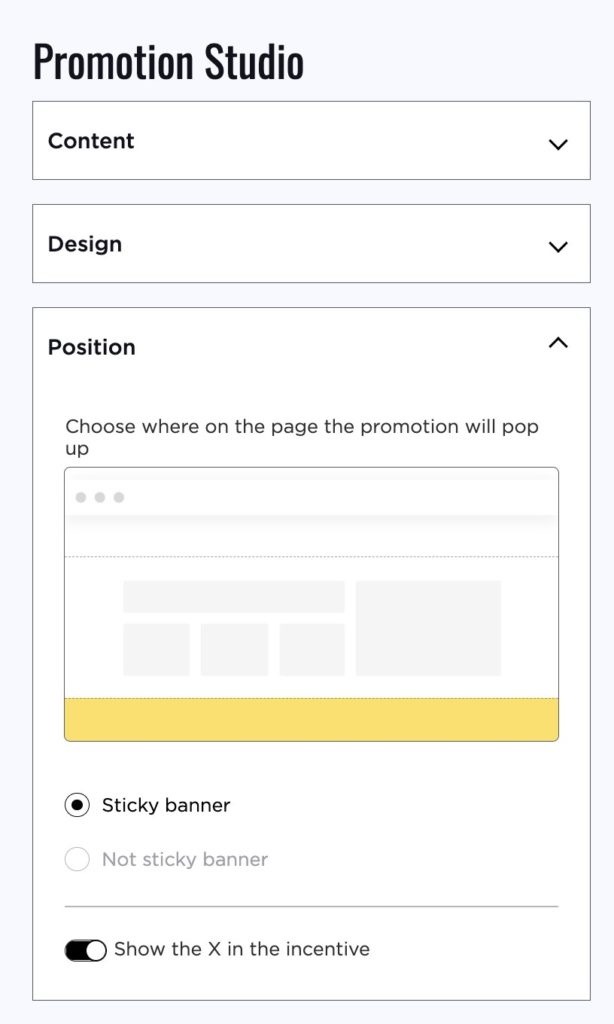
If you do set your banner to be sticky, however, make sure that you toggle the “Show the X in the incentive” on, so your visitors can exit out of it if they find it distracting.
Then, publish your promotion!
#8. Save Customer Carts Just-in-Time by Removing Hesitations
Remember that I cited earlier that 69% of shoppers abandon their online shopping carts?
This is a big problem for eCommerce teams, and it seems particularly painful because cart abandoners are users who made it all the way to the very bottom of the marketing funnel and still failed to convert.
Data shows that the device from which users are browsing influences their likelihood of abandonment. In fact, 74% of customers shopping from their mobile devices abandon their carts compared to 61% of desktop users.

This suggests that those browsing on their phones have a lower intent to purchase than those on their tablets or desktop, allowing you to create a powerful intent-based behavioral segment to identify would-be cart abandoners and:
- Deliver an incentive to keep those most likely to purchase on the page before they bounce (desktop users!)
- Engage mobile browsers in a more relevant way (like getting their email address or phone number!) and retarget or remarket to them when they’re on their desktop.
This strategy helps you to reduce cart abandonment and therefore increase conversion rates for desktop users by delivering an incentive right when the user shows signs of hesitation.
When I’ve done this for a client previously, we were able to convert nearly 1400 customers who were about to abandon their carts in around a month:

And that was with a generic discount offer! Imagine what you could do with an intent-based offer.
Not only does Intent-Based Promotions’ AI-driven engine predict the offer most likely to drive each user to convert; it also predicts when to serve it.
You can set this up in a few minutes with Intent-Based Promotions. Just start a new Ready to Use Campaign:
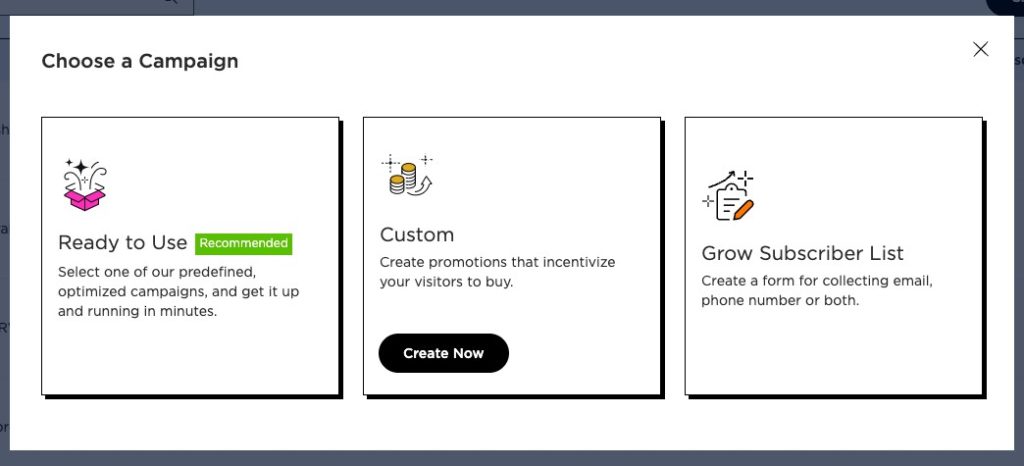
Choose Intent-Based under the Campaign Type.

Select the promotion type you would like to offer. I chose free shipping for my example. Under Display Rules, set the campaign to show only on the cart page.

Then, under Guidelines, select Inactivity. You can choose to display the pop-up after a certain amount of time has lapsed where the user is inactive. Lean on your analytics tools to determine the best amount of time.

Customize your campaign so it matches your branding and brand voice.
Hit publish and watch your cart abandonment rates go down.



